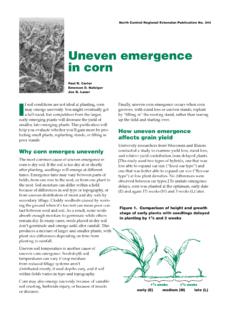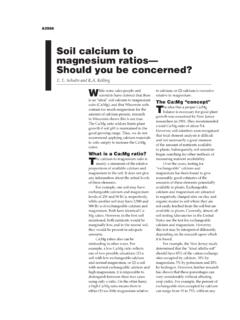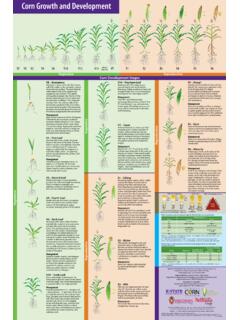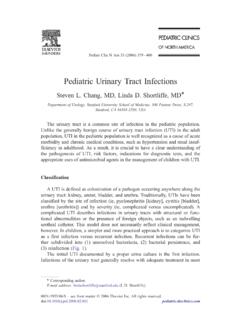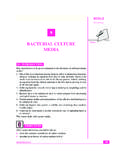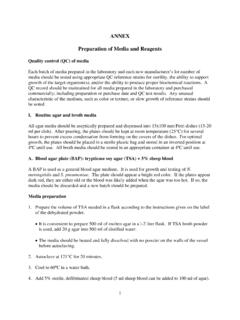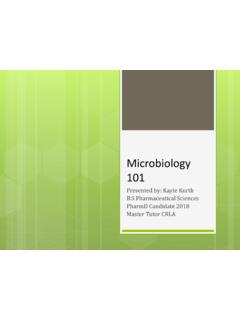Transcription of Origin, Adaptation, and Types of Corn
1 THE CORN CROP NCH-10 Origin, Adaptation, and Types of CornW. L. Brown, Pioneer Hi-Bred International, Inc., IA; M. S. Zuber, University of MIssouri; L. L. Darrah, USDA-ARS, University of MIssouri; and D. V. Glover, Purdue UniversityReviewers R. G. Creech, Mississippi State University A. A. Fleming, University of Georgia K. F. Schertz, USDA-ARS, Texas A&M University A. F. Troyer, DeKalb-Pfi zer Genetics, ILMay 1985 ORIGIN OF CORN Corn (Zea mays L.) is the only important cereal indigenous to the Western Hemisphere. Apparently originating in Mexico, it spread northward to Canada and southward to Argentina. While the possibility of secondary centers of origin in South America cannot be completely ruled out, the oldest (7000 years) archaeological corn was found in Mexico s Valley of Tehuacan.
2 The earliest corn of which there is record is unmistakably corn. The female infl orescence of this 5000 corn had reached a degree of specialization that precluded the possibility of natural seed dissemi-nation. Thus, the oldest corn of record was dependent upon man for its survival. Numerous theories of origin have been offered over the years, only two of which receive serious con-sideration today. One is that teosinte (Zea mexicana) is the wild progenitor of corn; the other is that a wild pod corn, now extinct, was the ancestor of domesti-cated corn. While perhaps more students of corn seem to accept the fi rst theory, others are equally convinced of the second.
3 Aside from its possible role in the origin of corn, teosinte has had major impact on its evolution. In Mexico particularly, introgression between corn and teosinte has likely occurred for centuries and continues to this day. The effects are apparent in the morphology and cytology of both species. There is also reason to be-lieve that genes for resistance to certain viruses have reached corn through its introgression with origin of corn may never be known with cer-tainty. One reason is that the hypotheses purporting to explain origin cannot be tested experimentally. There-fore, science would perhaps be better served if less attention were given to determining corn s origin and more to understanding the remarkable variability found within the and Races Regardless of origin, corn has proven to be one of the most adaptable and variable members of the grass family.
4 Its evolution, a large part of which apparently occurred under domestication, has resulted in biotypes with adaptation ranging from the tropics to the north temperate zone, from sea level to 12,000 feet altitude and growing periods (planting to maturity) extending from 6 weeks to 13 months. Almost 300 races of corn have been described from Mexico, Central and South America, and the Caribbean. Although many appear synonymous, at least 150 distinct entities have been collected in these areas. It was from certain of these races that most of the corns of North America were ultimately from Center of Origin Following discovery, corn moved quickly to Europe, Africa and Asia.
5 From Spain, it spread northward to the short-growing-season areas of France, Germany, Austria and eastern Europe, where selection for early maturity has produced some of the earliest commer-cial varieties of corn now available. In Italy and Spain, early counterparts of many South American races are evident even today. Although introduced into Africa soon after discovery, much of the corn now found in that continent is derived from later introductions from the southern , Mexico and parts of eastern South America. Most of southern Africa s corn traces back to varieties grown in the southern in colonial and post-colonial times. Corn NATIONALCORNHANDBOOKC ooperative Extension ServiceIowa State UniversityAmes, Iowa 500112of tropical middle (lowland) Africa is similar to the low-land and tropical corns of Central and South most widely used and productive corns of Asia are derived from Caribbean-type fl ints introduced in relatively recent times.
6 However, older and quite distinct Types of corn can also be found, for example, among the hill people of Mindanao in southern Philip-pines. Included are some small-eared, early-maturing fl ints or pops that either have the capacity to grow and mature quickly before being devastated by downy mildew or carry some genetic resistance to downy mildew. In the eastern Himalayas (Sikkim and Bhutan), a distinctive type of popcorn is found whose Western Hemisphere progenitors seem to have disappeared. When and how the ancestor of this corn reached Asia is not known. However, since it is not present on the Indian subcontinent to the south, it may have reached the Himalayas by way of China and Tibet.
7 In any event, a search for similar corns in south China and Tibet would seem justifi of the Corn Belt Whereas most of the modern races of corn are derived from prototypes developed by early native agriculturists of Mexico, Central and South America, one outstanding exception is solely the product of post-colonial North America the yellow dent corns that dominate the Corn Belt, Canada and much of Europe today. The origin and evolution of this remark-able race of corn have been clearly documented and confi rmed. In the early 1800s, two predominant races of corn of North America s eastern seaboard the late-matur-ing Virginia Gourdseed and the early-maturing North-eastern Flints were fi rst crossed, and the superiority of the hybrid recognized and described.
8 The cross was repeated many times during the western migration of settlers; and out of these mixtures eventually emerged the Corn Belt dents, the most productive race of corn found anywhere in the world. It was the highly selected varieties of Corn Belt dents that formed the basis of hybrid corn and the source of the fi rst inbred lines used to produce hybrids. Germplasm from some of these varieties (Reid, Lan-caster, Krug, etc.) still fi gure prominently in the ances-try of hybrids used in the Corn Belt even to this OF CORNDefi nition and Adaptation Worldwide Adaptation in corn means good performance with respect to yield and other agronomic characteristics in a given environment.
9 The environment includes all conditions to which the plant is subjected during the growing season (from pre-seedling emergence to harvest maturity). The major environmental factors are: (1) daily max-imum and minimum temperatures, (2) soil atmosphere and moisture levels, (3) humidity of the atmosphere immediately surrounding the plant, (4) wind move-ment, (5) day length, (6) light intensity, (7) air pollu-tion, (8) soil type, (9) soil fertility, (10) number of days exceeding 50 F, (11) competition from other plants including its intended neighbors as well as weeds, and (12) the disease-insect complex. Many of these factors interact in a complex man-ner to produce stress on the plant.
10 The plant s reac-tion to stress is under genetic control, and differences among hybrids exist. Corn breeders are continuously developing and testing new genetic combinations in differing environments to fi nd Types that give the best agronomic performance over a range of geographical locations and years. Corn is grown from sea-level to altitudes of more than 12,000 feet and from the equator to about 50 north and south latitudes. Compared to environmen-tal conditions of the Corn Belt, many producing areas would be considered very much substandard. In harsh-environment areas, the varieties grown would be considered adapted because they responded the best under the unfavorable growing conditions.
